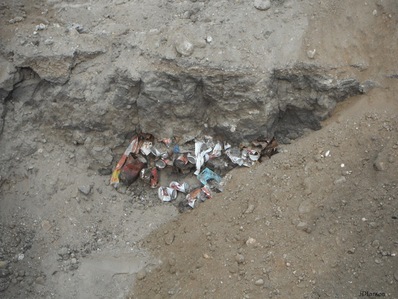 Does anyone else get the impression that people think that when we throw something away that it really goes "away" Well if you are one of those people I am sorry to disappoint you but the things you throw away really don't go away. Instead it ends up in our countries soil, waters, plants and it animals. If you are fortunate enough to live in a area that has a recycling program that will take some of this waste from you are lucky indeed. Even with recycling programs in place about 165 million out of the 250 million tons of trash that we produce is discarded and buried underground . The trash we discard is brought to landfills across the country where it is crushed into a compact layer and buried underground soil. To the right you will see two pictures I took at a recent sewer installation. What they show is trash such as pop/beer cans, plastics bags, scrap metals, and bit and pieces of indeterminate garbage. As near as we could figure the trash was from sometime in the 70's and has been buried and forgotten about for the past 40 years. The person who is having the sewer installed didn't even know it was there When most trash is recyclable and over 56% of municipal solid waste (MSW) is organic matter like kitchen scraps, food waste, paper, cardboard, old houseplants it makes very little sense to bury it with uncompostable or hazardous materials. To put perfectly decomposable food scraps or other organic matter (O.M) in the trash is both a waste both ecologically and a economically. Those scraps should be disposed of locally in a some sort of composting system whether that be the standard pile in the back yard or a more advanced system using a composting bin or barrel to break down the organic matter. Depending on what system you have and what sort of organic matter is in the system the O.M. can be broken down in a couple of months or a matter of weeks. Some of the more advanced systems such as All Seasons Indoor Composter are able to be in your kitchen right next to your trash can and through the miracle of technology and design can produce good compost very quickly. Some other good alternatives would include either a worm composting bin or rotating drum composters. I personally am a fan of the the rotating drum bins since I have seem them in action and I know they produce great compost and "compost tea". The compost tea is a nutrient rich liquid and can leak out of these bins and when caught in some convenient buckets, it makes a great liquid fertilizer. I personally have not had much success with worms bins in my attempts to use them but I feel that was the fault of my technique and the homemade bin I created. I think with some of the commercial bins that are available and the proper variety and amount of worms a worm bin is a great indoor or outdoor composter. Nearly everything that goes to the dump these days could be saved, repurposed or disposed of in a much better way than had been done in the past. All metals should be salvaged and if not usable in their present state should be melted down and remade into something new. Any wood scraps can either be burned as a biomass fuel or chipped up to use as garden mulch and even plastics should be recycled or "downcycled" as is most likely the case into something else. We have to do more as a society to curb the amount of trash that we put into the ground where is does no one any good. We can do this by moving past the the throw it away mentality that has been drilled into us over the course of our lives.
0 Comments
Leave a Reply. |
AuthorHello my name is Josh Larson and I am the creator of the Green Living Library. Here on the blog you will find updates to content found in the Green Living Library as well as stories from those living the sustainable life already. Archives
December 2021
Categories
All
|